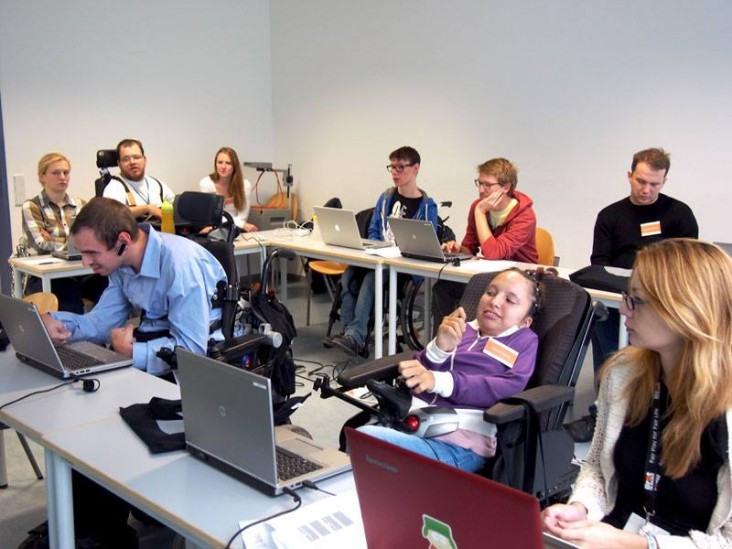
August 2015—In the last five years, a vital lesson has been circulating throughout Macedonia’s education system: For people without disabilities, technology makes things easier. For people with disabilities, technology is what makes things possible.
Viktorija Penova was born with fibrodyspasia ossificans progressiva, a rare health condition that significantly restricts her mobility. When she became old enough to enroll in the local primary school, there were no accommodations for physically disabled students, and her parents weren’t certain their daughter would be able to attend. That their otherwise bright and capable child might not get an education was a very real possibility.
Though many at the school worked together to make it happen, they remained ill-equipped. The principal remembers “her mother used to carry her from one classroom to another.”
When Viktorija entered the fourth grade, she transferred to Josip Broz Tito primary school in the nearby municipality of Valandovo, where USAID’s E-Accessible Education project had just begun working with staff and students. A number of relatively simple adjustments—both logistical and technical—changed Viktorija’s world.
With project guidance and advocacy, the school secured funding from the municipality and a local business to have a specialized electric wheelchair made for her. They built a ramp at the main entrance and re-assigned classrooms so that all her classes would be on the ground floor. She uses a computer with a virtual keyboard and trackball.
Like a mouse, the trackball controls the cursor with right and left clicks, but is less sensitive to broader movements across the table than a traditional mouse. For Viktorija, who has difficulty with large muscle movements yet still has good fine motor skills, the trackball works very well. The virtual keyboard appears on her computer screen and allows her to click on the keys with the cursor—a much easier motion for her than tapping keys on a traditional keyboard.
Other assistive technologies include large button keyboards for students with visual impairments and/or motor skills difficulties, and the adapted joystick—another mouse substitute that can be guided with an elbow, a foot or even a chin.
When USAID launched the E-Accessibility project five years ago in Macedonia, the notions of inclusive education and accessibility had not yet taken hold in either the education sphere or the broader public consciousness. A survey revealed that more than 80 percent of schools had at least one student with special educational needs, yet fewer than 20 percent of schools had an accessible entrance ramp. The use of assistive computer technologies and software was virtually unknown.
The project, which ran from February 2010 to June 2015, provided special computer technologies to 33 schools. It trained over 1,200 teachers, school professionals, municipal and Bureau for Development of Education advisers, and parents in inclusive teaching practices and the use of assistive technology with disabled students. The project also provided ongoing guidance and produced a variety of resource materials: manuals and guidebooks for teachers, the first electronic textbooks, and educational software.
The software produced by the project focused on interactive math and reading games appropriate for all elementary students but with a variety of integrated accommodations for disabled students. For example, the games work well with joystick and trackball users as well as those using a traditional mouse, and the graphics are large and free of excess ornamentation to make them easier for visually impaired students to recognize text and images.
Now in her second year at Goce Delcev high school, Viktorija is in many ways like most of the other students at her school. She moves about independently, hangs out with friends, plays computer games, surfs the Internet, is a passionate Manchester United fan, and dreams of a career in computer design and programming.
In other ways, her story is really quite extraordinary. The young girl, whose access to an education was once dependent on her mother’s ability to carry her from classroom to classroom, is now a successful high school student and was recently a keynote speaker alongside the U.S. ambassador at a project press conference. Over the summer of 2014, she traveled abroad to Austria without her parents to attend an international camp on communication and computers for people with motor disabilities.
This USAID project made it possible for 350 Macedonian students with disabilities to actively participate in mainstream classroom activities, significantly enhance their knowledge, obtain new skills, and build their self-esteem. USAID and its implementing partner, Open the Windows, worked hand-in-hand with the Ministry of Education and Science and the Ministry of Information Society and Administration to raise awareness and change attitudes throughout the educational sector, paving the way for many more disabled students to follow.
LINKS
Follow @USAIDMacedonia, on Facebook, on YouTube







Comment
Make a general inquiry or suggest an improvement.